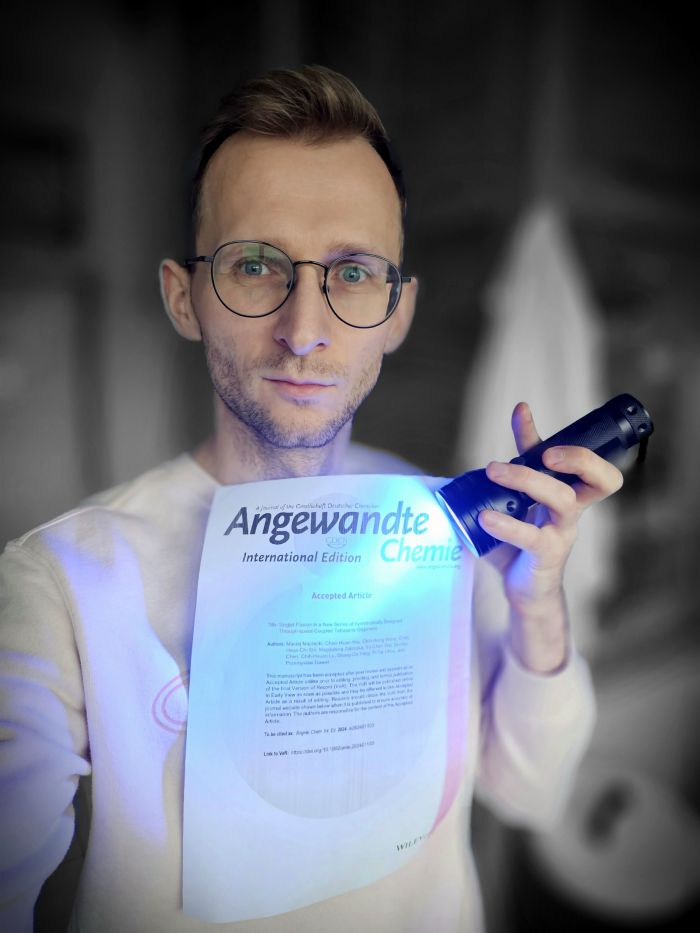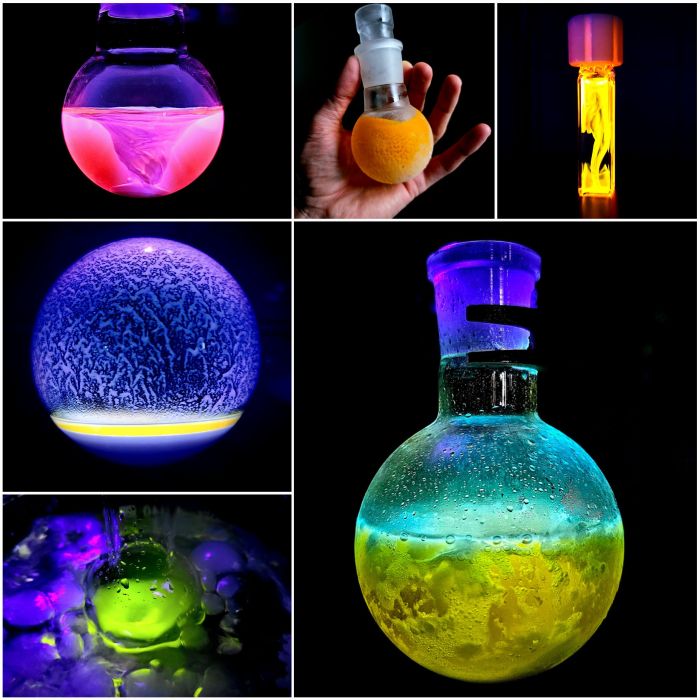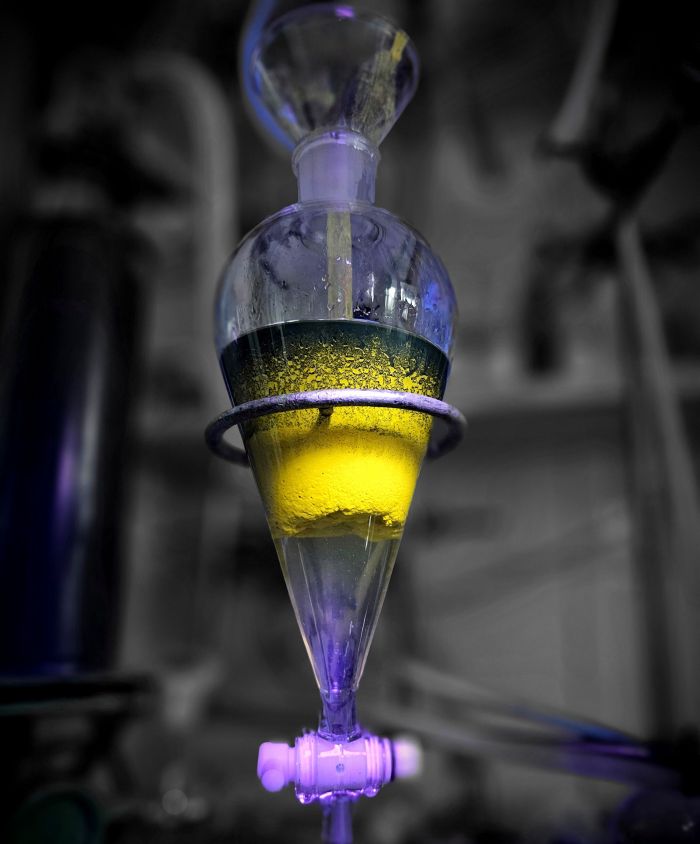
When the molecules of a certain compound - tetracene - are arranged in the shape of a nano-snowflake, singlet fission occurs - a process that obtains as many as two electrons from one photon, Polish and Taiwanese scientists have shown. They hope that their research will help improve the efficiency of solar panels.
The research was conducted under the supervision of Dr. Przemysław Gaweł from the Institute of Organic Chemistry at the Polish Academy of Sciences. The first author of the paper published in the prestigious journal Angewandte Chemie is Dr. Maciej Majdecki from the Institute of Organic Chemistry PAS. He is a hobby photographer who presents the beauty of chemical reactions and fluorescent compounds on his highly respected online profiles (luminescent_chemist). Thanks to the extraordinary UV lighting, the scientist shows how beautiful the work of a chemist can be. The photographs also show his research on compounds that can improve the functioning of solar panels.

NOT THE MOST POWERFUL CELL
'For now, the maximum theoretical efficiency of photovoltaic cells may reach 33 percent,’ Dr. Majdecki tells PAP. This means that every third photon that hits a solar cell leads to the release of an electron (this is where the current comes from). Unfortunately, many of the photons hitting the panel are converted into heat, which is not used in the panels and even reduces their efficiency and durability. The vast majority of solar energy, however, is not utilized.
A PHOTON AND TWO ELECTRONS
Using processes that will convert light into electricity more efficiently gives hope for increasing the efficiency of cells. These processes include singlet fission. In this process, if one photon hits a given structure, it can produce as many as two electrons. 'And this means that the efficiency of this process is as much as 200 percent,’ says Dr. Majdecki.

The advantage of singlet fission is that it can be used in the currently widely used silicon-based panels. This process would take place in one of the many layers of the silicon cell. 'Research shows that it would be possible to increase the maximum efficiency of cells by up to 45 percent. There is something to fight for,’ says Dr. Majdecki.
The scientist adds that this is a fairly new research topic. So far, molecules of a certain organic compound - pentacene (it can be found in tar, it is made of five linearly connected carbon rings - benzene molecules) - have been used for singlet fission reactions.
'Pentacene is great for singlet fission, but unfortunately the energy of the generated electrons is not adapted to the energy levels of silicon semiconductors - the basic components of cells. Scientists are looking for other molecules that would work better with silicon,’ says Majdecki.
TETRACENE FOR FREE
The research of Dr. Gaweł's team from the Institute of Organic Chemistry PAS concerns tetracene. It is a 'smaller cousin' of pentacene - a hydrocarbon consisting of four benzene rings. This compound (inexpensive to obtain, orange powder) works much better because the portions of energy released in it harmonize perfectly with the properties of silicon.
'Our publication shows that from this compound, the single molecule of which does not carry out singlet fission, we can achieve the maximum in the conversion of light into energy. However, this requires precise molecular tailoring and the preparation of an oligomer with an appropriate structure from this compound,’ Dr. Gaweł says.
An oligomer is a structure smaller than a polymer - a molecule composed of several (at most six) fragments - monomers.
STAR POWERS
Chemists used a 'molecular bowl' to arrange tetracene monomers into nano-snowflakes. Thanks to the proper arrangement of the molecules in the oligomer, it was possible to gradually increase the efficiency of singlet fission in tetracene from approximately 50 to 200%.
So if a 'two-armed' tetracene snowflake needed two photons to obtain one electron, a 'six-armed' snowflake using one photon was already able to release two electrons (with energy compatible with silicon), which is as much as possible. The processes taking place in subsequent arms of the oligomer were coupled and mutually reinforced.
Interestingly, molecules are separated in the tetracene nano-snowflake. The central core keeps them in close proximity, but not directly connected.
The methods and compounds that chemists used to sew hydrocarbon snowflakes are already of interest to scientists who are working on other phenomena that increase the efficiency of photovoltaics.
A SMALL BUT…
The singlet fission efficiency and energy portions obtained in tetracene snowflakes are therefore great, and the process of producing nano-snowflakes could be cheap. However, the stability of tetracene is still a problem because, unfortunately, light has a destructive effect on this compound. Dr. Majdecki recalls that he did not even try to capture the tetracene nano-snowflakes in photos because they quickly deteriorated under the influence of UV light.

Deterioration under the influence of light is certainly not a desirable property in materials that will be constantly exposed to sunlight. 'However, we are fighting to get around this problem and obtain a stable compound,’ says Dr. Majdecki.
Another problem is that so far the properties of tetracene snowflakes have only been studied in a solution - because it is simpler. There are indications that these properties will be much better in a solid than in a solution. However, the team from the Institute of Organic Chemistry PAS is not able to investigate this - another team is needed to test the chemists' idea in a prototype device.
'This is often a problem for us. We design and produce molecules with truly extraordinary properties, but then the Polish industry is not interested in our results and our work has no application,’ says Dr. Majdecki.
PAP - Science in Poland, Ludwika Tomala
lt/ zan/ kap/
tr. RL













